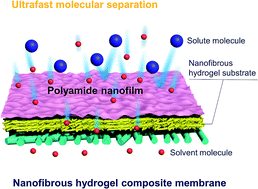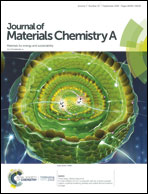Nanofibrous hydrogel composite membranes with ultrafast transport performance for molecular separation in organic solvents†
Abstract
Membranes with high solvent permeance and excellent molecular sieving characteristics are highly desirable for energy-efficient organic liquid separation. However, the “trade-off” relationship between permeability and solute selectivity remains a challenge for thin film composite (TFC) polymeric membranes. Herein, we report a facile and scalable fabrication technique for a high performance and solvent-resistant TFC membrane based on a nanofibrous hydrogel network. Aramid nanofibers (ANF) with a diameter of ∼12.3 nm were used to construct a three-dimensional interconnected hydrogel structure and to obtain a homogeneous diffusion of the aqueous solution. A polyamide (PA) nanofilm with a thickness down to 62 nm was successfully fabricated on the nanofibrous hydrogel support via controlled interfacial polymerization (IP) and was found to have an unprecedented solvent permeation for mild polar solvents (methanol: 54.0 L m−2 h−1 bar−1) and aggressive organic solvents (acetone: 70.0 L m−2 h−1 bar−1, dimethyl formamide: 34.0 L m−2 h−1 bar−1). These permeabilities are over two orders of magnitude higher than those of commercial membranes, with a similar selectivity. The ease of preparation stimulates industrial scale-up and opens up future possibilities for applications in molecular separation, solvent recovery, water treatment and water desalination.



 Please wait while we load your content...
Please wait while we load your content...